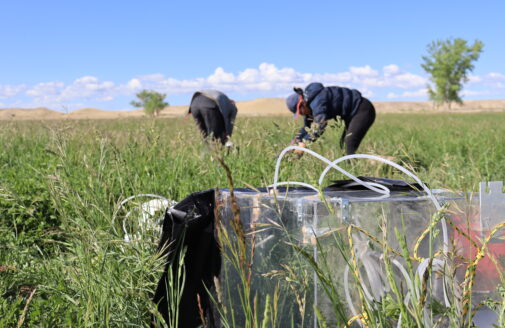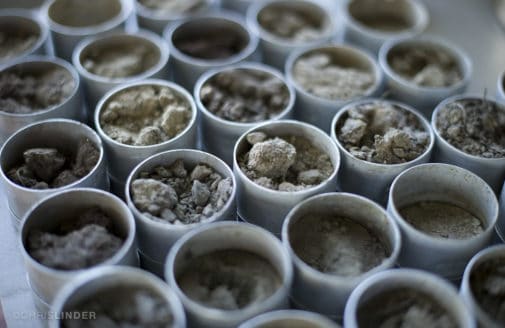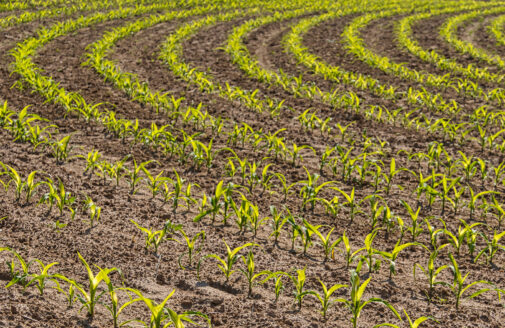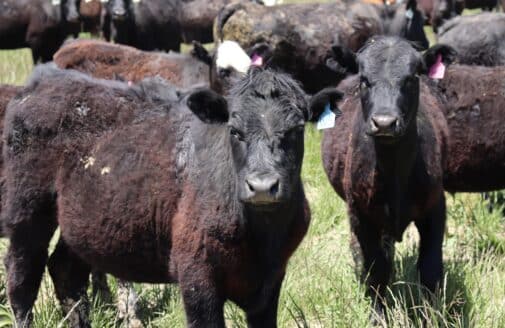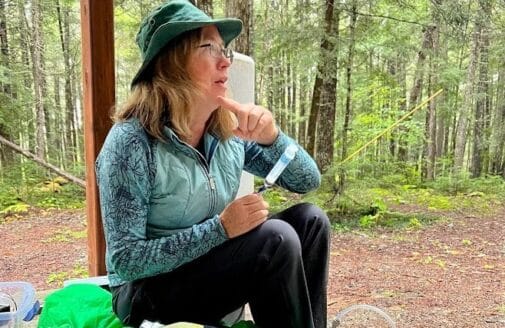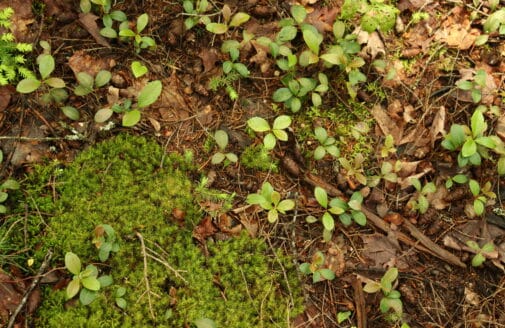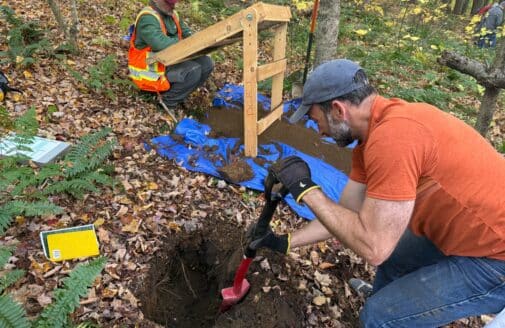Scanning the soil to unlock its secrets
Woodwell Climate research builds community resources to advance soil science for climate solutions
Colleen Smith uses a handheld soil spectrometer to scan soils from a ranch in Colorado.
photo by Sarah Ruiz
Research Assistant Colleen Smith crouches low to the ground over a tray of crumbled soil. Using a boxy grey device that looks like a heavy-duty flashlight, she presses the flat glass end against the soil and fires a beam of infrared energy that bounces off the soil and back into the device’s sensor.
In moments, a readout pops up on a tablet screen, showing a spectrum of reflected light. With some analysis, Smith will have data on the chemical makeup of this patch of ground. With enough data points, she could estimate the soil properties of an entire field, pasture, ranch or farm, and how it might be changing over time.
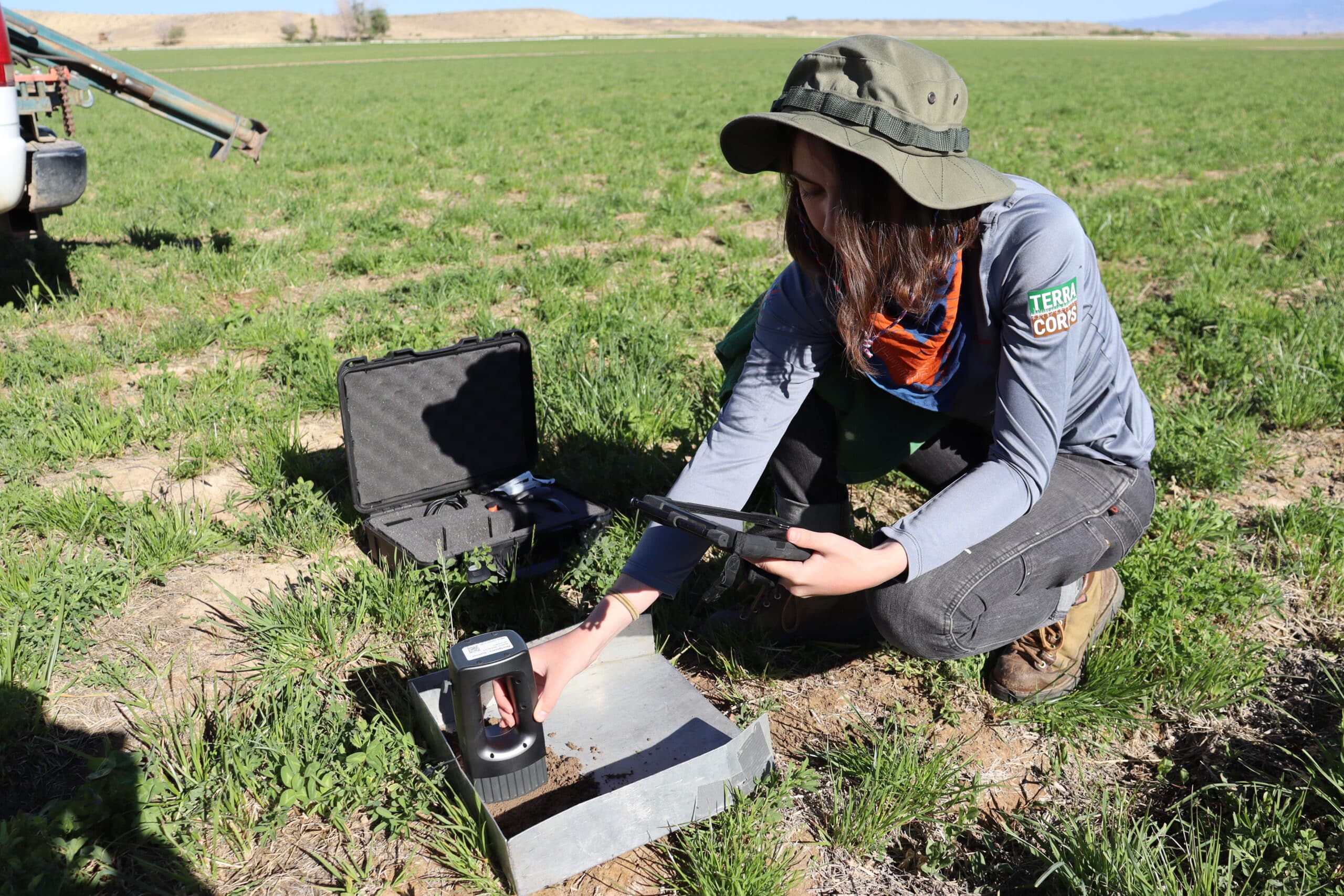
Smith checks the read-out from a spectral scan.
photo by Sarah Ruiz
Soil spectroscopy is a newer but fast-growing technique employed by scientists studying soil composition. At Woodwell Climate Research Center, a group led by Carbon Program Director Dr. Jonathan Sanderman has been spearheading its use to help improve the availability and affordability of reliable soil quality information, which is essential if we want to get serious about soil carbon sequestration as a natural climate solution.
Why soil spectroscopy?
“The heart of the technology is essentially getting the fingerprint of the soil, which tells us something about the overall chemical makeup of that sample,” says Dr. Sanderman.
The principles of soil spectroscopy are based in nuclear physics. Elements in the soil react in unique ways to the energy from the electromagnetic spectrum, reflecting some wavelengths and absorbing others. The reflected wavelengths give scientists clues to which minerals and elements are present and in what quantities.
That information can then be related to certain soil properties, like whether it’s suitable for certain crops, or whether it’s effectively sequestering carbon. The former is valuable information for producers like ranchers or farmers who need to make land management decisions. The latter is what climate researchers are most interested in. Soil spectroscopy represents an opportunity to marry the interests of both.
In a single scan, soil spectroscopy can estimate carbon, nitrogen, phosphorus, moisture, pH levels, and more. Traditional methods rely on multi-step chemical analyses to get you the same information—a time consuming and expensive process that could involve grinding, drying, weighing, mixing with reagents, and other steps to extract information on just one or two indicators of soil quality.
“With soil spectroscopy, you can get a pretty large suite of properties from one sixty second scan. A lab needs easily $2 million worth of instruments to be able to make all the same measurements using traditional methods,” says Dr. Sanderman. The most precise soil spectrometers can cost $100,000, but lower resolution and portable ones are substantially cheaper. “The speed and cost of spectroscopy are unmatched.”
Soil Spectroscopy for Global Good
These benefits make soil spectroscopy a method with big potential, but according to Sanderman there is still work to be done in refining the methodology to get universally accurate data. Alongside collaborators from the University of Florida and OpenGeoHub, he started the Soil Spectroscopy for the Global Good project (SS4GG) to jumpstart that work.
The project focused on two main efforts. The first was an extensive inter-laboratory comparison to understand how much the accuracy of scans varies between different instruments. Twenty laboratories across the globe participated, scanning identical samples which were then compared to the output from a lab widely regarded as the gold-standard in accuracy. The results were published in Geoderma late last year.
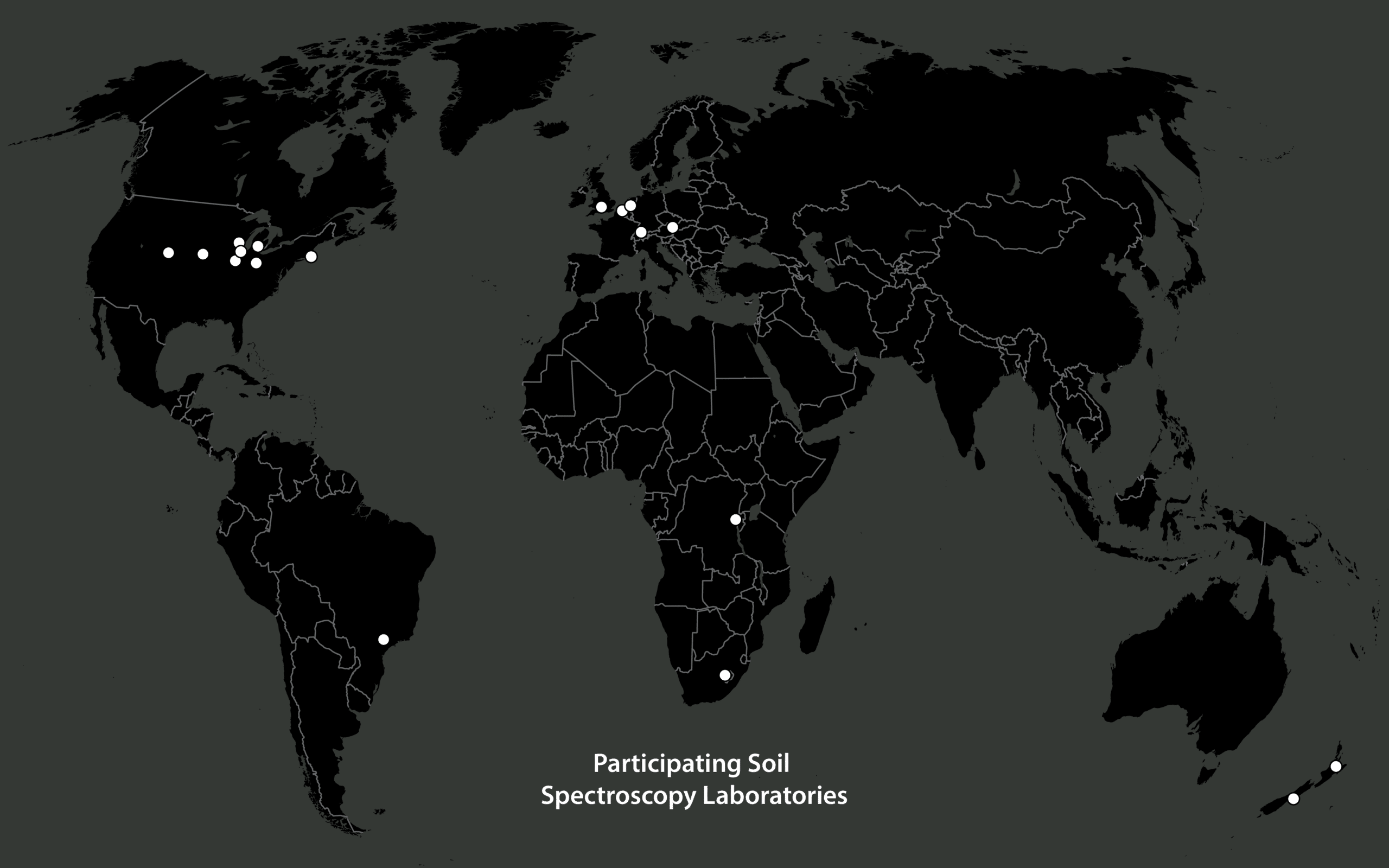
map by Christina Shintani
“We demonstrated that there is lab-to-lab variability, but also that there are procedures we can use to correct for differences between laboratories and get better integration of data,” says Postdoctoral Researcher, Dr. José Safanelli, who coordinated the study.
The second goal was to pool data from different labs into one accessible and open-source resource that also provides tools to analyze the data. The Open Soil Spectral Library (OSSL) now hosts over 100,000 soil spectra from across the globe that scientists can incorporate into their research and offers an engine for analysis. The idea is that with more people using and contributing soil spectral data, the faster the technology and the information gained from it will advance.
“We hope that the OSSL will be a driver of the soil spectroscopy community, advancing the pace of scientific discovery, and promoting innovation,” says Safanelli.
The Open Soil Spectral Library hosts data from around the world.
Building a community of soil scientists
Throughout the project, SS4GG efforts remained dedicated to transparency.
“We were always available to answer questions. We shared best practices and gave advice on which instruments are better, which manufacturers are the best in the market, and which procedures to use to collect spectra,” says Safanelli.
According to Sanderman, that openness fostered trust and collaboration—in both contributing data to the OSSL and participating in the inter-laboratory study—strengthening the community of scientists using soil spectroscopy.
“As we built momentum, more groups began to contribute,” says Sanderman. “It’s been great to see people realizing the value of collaborative, open science. People are now taking advantage of the foundation we’ve built.”
The soil spectroscopy community convened this past year for several webinars and presentations, including the Agronomy, Crop, and Soil Science Society meeting, where Sanderman and Safanelli hosted a training workshop and symposium on spectroscopy, as well as a two-day immersive workshop on the future of the field.
“We all benefit when this technology is more widely used,” says Smith.
Smith and Sanderman preparing and scanning soils from Valdez Ranch, Colorado.
photo by Sarah Ruiz
Soil carbon as a climate solution
Speeding up the pace of soil science is key for developing climate solutions. Agricultural soils represent a large potential carbon sink; changes in farming and ranching practices can encourage sequestration of carbon in the soils. Soil carbon markets, and other payment for ecosystem services schemes could incentivize producers to make sustainable management decisions and soil spectroscopy could be a useful tool to track their contributions.
“The ultimate goal is to better monitor soils across landscapes to make food production more sustainable,” says Safanelli.
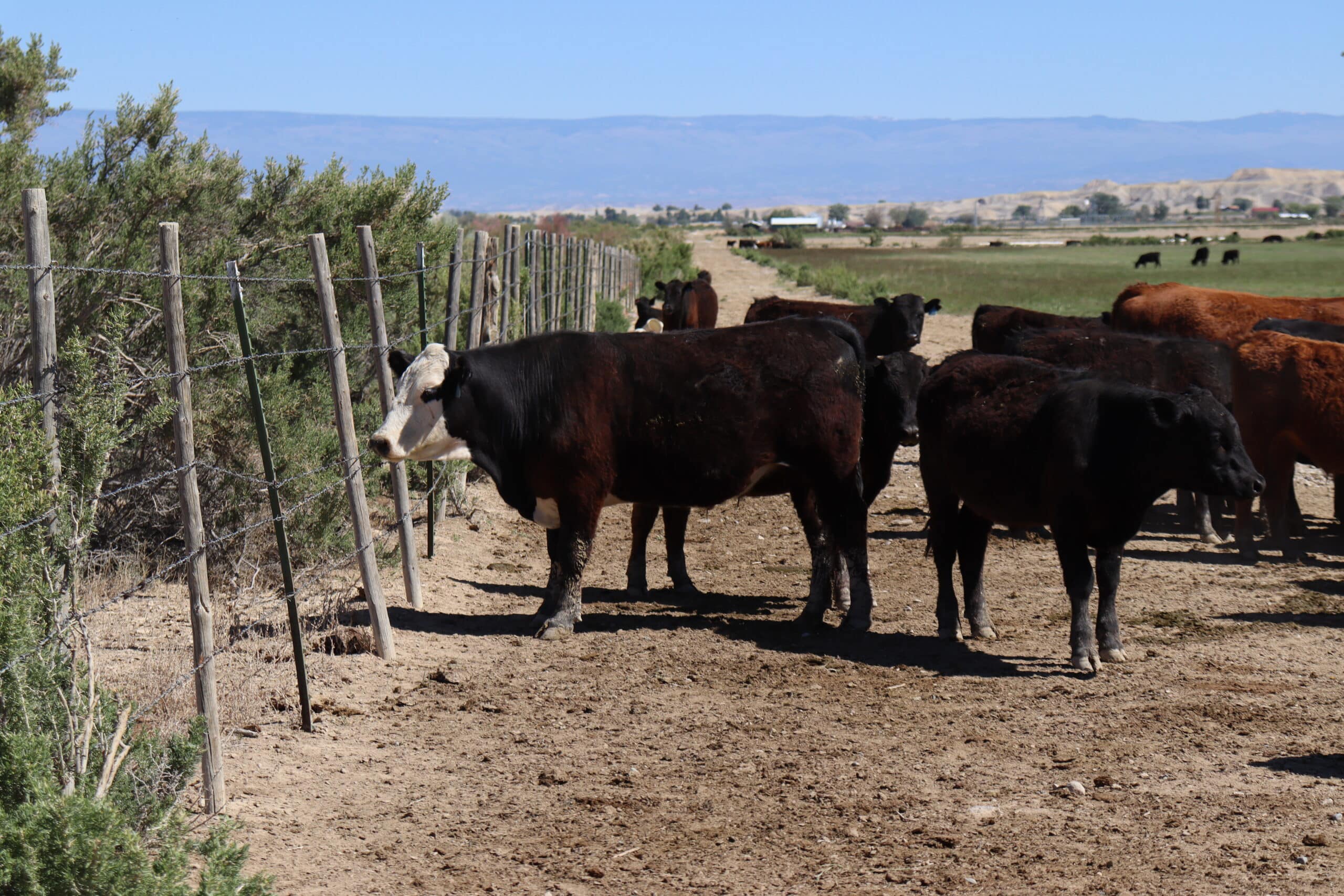
Cattle on Valdez Ranch, Colorado.
photo by Sarah Ruiz
The handheld device that Smith was using is a test case for the speed and convenience of soil spectroscopy for analyzing soil carbon. If testing the quality of your soils can be as simple as a 60 second measurement with a low-cost piece of portable equipment, and the scan can get you additional information about soil fertility, then why not participate?
“We are trying to verify that we actually are sequestering carbon, and that requires lots and lots of measurements. So this is where we start moving into field-based spectroscopy,” says Sanderman. “If we can eliminate bringing the sample back to the lab altogether, we’re cutting our costs by another order of magnitude and could potentially scan several hundred points in a field in a day.”
Smith theorizes that cost could be further diffused through farming cooperatives or extension offices offering soil testing using inexpensive spectrometers. “Soil spectroscopy could be an easier way to get answers to big questions,” says Smith. “And that’s exciting.”
With the OSSL now up and running, the team is now focusing efforts on maintaining the growing network of interested soil researchers, pursuing new opportunities for collaboration as they arise.
“The network is getting stronger,” says Safanelli. “More people are coming and reaching out to us. That’s our biggest contribution: creating a network and sharing information across the community.”




